
Alien 8 is an action-adventure video game developed and published by Ultimate Play the Game. It was released for the ZX Spectrum, BBC Micro, Amstrad CPC and MSX in 1985. The game is a spiritual successor to the best-selling Knight Lore, which was lauded by critics for its isometric graphics. In the game, the player takes control of a robot, Alien 8, whose job is to ensure that all of the cryogenically frozen passengers on board a starship remain viable during the ship's voyage.

Knight Lore is a 1984 action-adventure game developed and published by Ultimate Play the Game, and written by company founders Chris and Tim Stamper. The game is known for its use of isometric graphics, which it further popularized in video games. In Knight Lore, the player character Sabreman has forty days to collect objects throughout a castle and brew a cure to his werewolf curse. Each castle room is depicted in monochrome on its own screen and consists of blocks to climb, obstacles to avoid, and puzzles to solve.
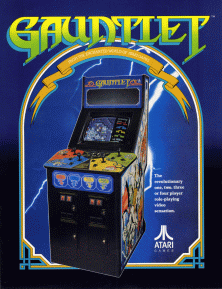
Gauntlet is a 1985 fantasy-themed hack-and-slash arcade game developed and released by Atari Games. It is noted as being one of the first multiplayer dungeon crawl arcade games. The core design of Gauntlet comes from 1983 Atari 8-bit dungeon crawl game Dandy, which resulted in a threat of legal action. It also bears striking similarities to the action-adventure maze game Time Bandit (1983).

Theatre Europe is a turn-based strategy video game developed and published by Personal Software Services (PSS). It was first released in the United Kingdom for the Commodore 64, ZX Spectrum, Amstrad CPC and Atari 8-bit family home computers in 1985. It was later released in France by ERE Informatique in 1986, and was released in the United States by Datasoft later that year. A port for the Tatung Einstein was released in 1989, in the UK. It is the fifth installment of the Strategic Wargames series.
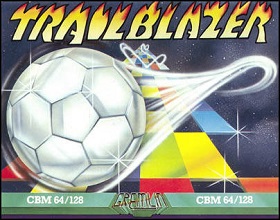
Trailblazer is a racing video game developed by Mr. Chip Software and published by Gremlin Graphics for the ZX Spectrum, Commodore 64, Atari 8-bit family, Amstrad CPC and Commodore 16/Plus/4 in 1986. It was ported to the Amiga and Atari ST.

Tornado Low Level is a multidirectional flight game developed by Costa Panayi and published in 1984 by the company he co-founded, Vortex Software. The game was released for the ZX Spectrum in 1984, with ports for the Amstrad CPC and Commodore 64 in 1985.
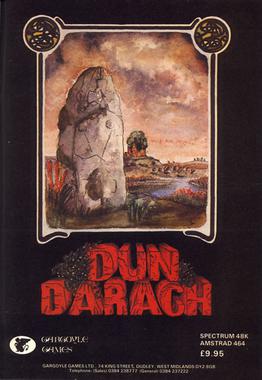
Dun Darach is an arcade adventure developed and published in 1985 by Gargoyle Games for the ZX Spectrum and Amstrad CPC computers. It is a prequel to the 1984 game Tir Na Nog. The plot has Celtic hero Cuchulainn on a search to find his companion Lóeg in the mysterious city of Dun Darach. Inspiration for the game came from the works of Fritz Leiber and Michael Moorcock.
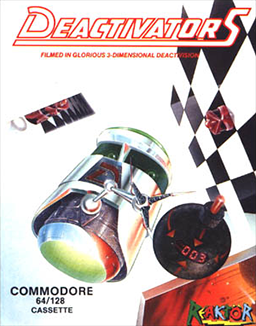
Deactivators is a 1986 puzzle video game designed by David Bishop and Chris Palmer, developed by Tigress Marketing and System Software, and published by Ariolasoft's action game imprint Reaktor. The player controls bomb disposal robots known as deactivators and must use them to deactivate bombs planted by terrorists in five research complexes. The concept for the game came from a brainstorming session between Bishop and Palmer; its design and development took five to six months to complete. It was released for the Amstrad CPC 464, Commodore 64, and ZX Spectrum platforms in October 1986.

Zub is a 1986 platform video game designed by Ste and John Pickford, developed by Binary Design, and published by Mastertronic for the Amstrad CPC, Commodore 64 and ZX Spectrum. The game has the player control Zub, who has to travel to different planets to retrieve the Green Eyeball of Zub. A parody of the game Light Force, called Lightfarce, was added in as an easter egg. The music on all computers was composed by David Whittaker.

Battle of Britain is a turn-based strategy video game developed and published by Personal Software Services for the Commodore 64 in 1985. It was also ported to the Amstrad CPC and ZX Spectrum the next year. It is the seventh instalment to the Strategic Wargames series. The game is set during the Battle of Britain campaign of the Second World War and revolves around Britain's defence and prevention against a Nazi invasion. In the game, the player commands the Royal Air Force as they must defend key cities against the Luftwaffe.

Heartland is a platform game for the ZX Spectrum, Amstrad CPC, and Commodore 64 released by Odin Computer Graphics in 1986.

Light Force is a 1986 vertically scrolling shooter designed by Greg Follis and Roy Carter, developed by their company Gargoyle Games, and published under their Faster Than Light imprint. It was released for the Amstrad CPC, Commodore 64, and ZX Spectrum platforms.

Zoids: The Battle Begins is a 1986 video game designed by Chris Fayers, developed by the Electric Pencil Company, and published by Martech. and released in Europe for the ZX Spectrum, Amstrad CPC, MSX and Commodore 64 computers. Based on the Zoids toy series, the player controls a human who was fused with one of the robots and has to reclaim parts of a larger mech.

Falklands '82 is a 1986 turn-based strategy video game developed and published by Personal Software Services for the ZX Spectrum and Commodore 64. It is the fifth instalment of the Strategic Wargames series. The game is set during the 1982 Falklands War and revolves around the Argentine occupation and subsequent British re-capture of the Falkland Islands. The player controls the British Task Force as they must either defeat all Argentine forces on the archipelago or re-capture every settlement.

Battlefield Germany is a turn-based strategy video game developed and published by Personal Software Services for the Commodore 64 released in April 1987. It was also ported to the Amstrad CPC and ZX Spectrum later that year. It is the eighth instalment to the Strategic Wargames series. The game is set during a fictional scenario in which the powers of NATO and the Warsaw Pact engage in a conventional war throughout Europe, mostly centring in West and East Germany.
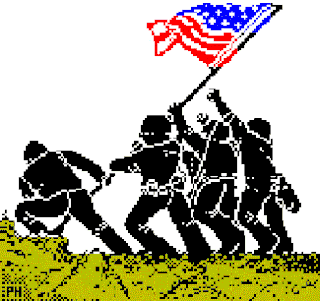
Iwo Jima is a turn-based strategy video game developed and published by Personal Software Services for the Commodore 64 and ZX Spectrum in 1986. It is the second instalment to the Strategic Wargames series. The game is set during the Battle of Iwo Jima in the Pacific Ocean theatre of World War II and revolves around the United States Marine Corps' objective to secure the island of Iwo Jima from the Imperial Japanese Army.

Swords and Sorcery is a fantasy role playing video game developed and published by Personal Software Services. It was released exclusively in the United Kingdom for the ZX Spectrum in 1985 and the Amstrad CPC in 1986. The game contains elements of dungeon crawling and revolves around a customisable player-character navigating through catacombs in order to secure a large wealth of treasure, whilst simultaneously collecting seven pieces of sacred armour.

Ace is a combat flight simulator video game published for the Commodore 64, VIC-20, and Plus/4 in 1985 by Cascade Games. It was ported to the Amstrad CPC, Amstrad PCW, Amiga, and ZX Spectrum.

Pegasus Bridge is a turn-based strategy video game developed and published by Personal Software Services. It was released exclusively in the United Kingdom for the ZX Spectrum, Amstrad CPC and Commodore 64 in 1987. It is the ninth installment of the Wargamers series. The game is set during the landings in Normandy on D-Day in the Second World War and revolves around the British 6th Airborne Division's attempts to secure a bridge over the Caen Canal.

Spitfire 40 is a combat flight simulation video game developed by Novotrade and published by Mirrorsoft for the Commodore 64 in 1985.





















